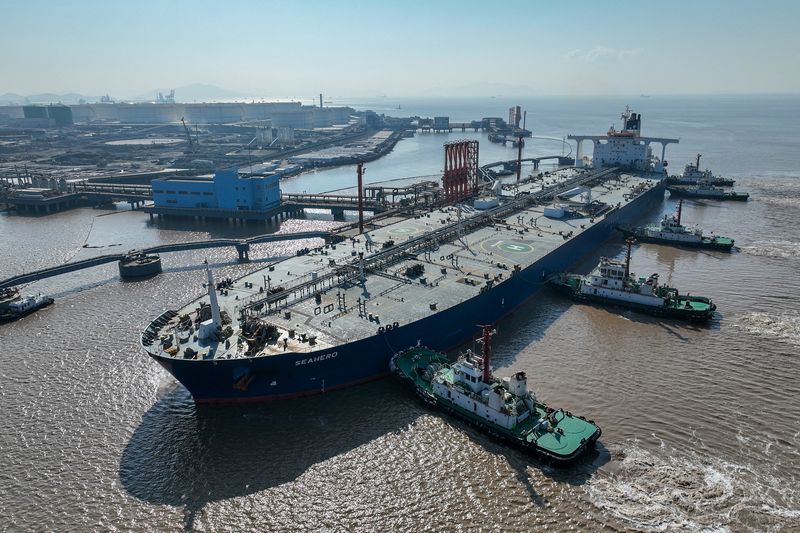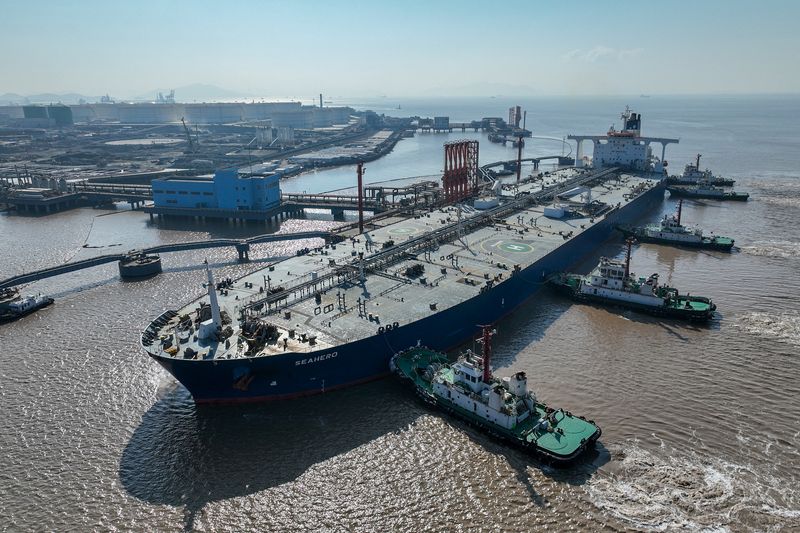Commodities
Oil prices up 3% on worries about Middle East supplies


© Reuters. FILE PHOTO: An aerial view shows a crude oil tanker at an oil terminal off Waidiao island in Zhoushan, Zhejiang province, China January 4, 2023/File Photo
By Scott DiSavino
NEW YORK (Reuters) -Oil prices climbed about 3% to a one-week high on Friday on worries that tensions in Israel and Gaza could spread into a wider conflict that could disrupt global crude supplies.
Brent futures rose $2.55, or 2.9%, to settle at $90.48 a barrel, while U.S. West Texas Intermediate (WTI) crude rose $2.33, or 2.8%, to settle at $85.54.
Brent’s premium over WTI rose to its highest since March, making it more attractive for energy firms to send ships to the U.S. to pick up crude for export.
For the week, Brent was down about 2% and WTI down about 4%.
Trading was choppy. Early in the session, oil prices soared by more than $2 a barrel after the U.S military struck Iranian targets in Syria. Then prices briefly turned negative as markets digested various reports on mediation talks between the militant Hamas group and Israel led by Qatar in coordination with the U.S.
“We are at the mercy of the next headline … and I think that’s kind of what we’ve been seeing today with the price swings,” said Phil Flynn, an analyst at Price Futures Group.
“You’d like to be trading the fundamentals, but you really can’t because you’ve got to be more worried about … what’s going to happen in the Middle East,” Flynn said. “No one wants to be short over the weekend.”
Israeli air and ground forces were stepping up operations in the Gaza Strip amid reports of heavy bombing of the besieged enclave.
A Hamas official, meanwhile, conditioned the release of hostages in Gaza on a ceasefire in Israel’s bombardment of the Palestinian enclave, launched after a deadly Hamas rampage into southern Israel nearly three weeks ago.
Several countries, including many Arab states, have urged Israel to delay a planned ground invasion that would multiply civilian casualties and might ignite a wider conflict.
RED LINES
Middle East developments have so far not directly affected oil supplies, but many fear disruptions of exports from major crude producer and Hamas backer Iran and others.
“(It) remains incredibly difficult even for the most knowledgeable regional watchers to make high conviction calls about the trajectory of the current crisis, as the red lines that could bring more players onto the battlefield remain largely indiscernible,” RBC Capital analyst Helima Croft said.
Goldman Sachs analysts retained their first-quarter 2024 price forecast at $95 a barrel but added that lower Iranian exports could cause baseline prices to rise by 5%.
Prospects for oil demand were uncertain.
U.S. consumer spending surged in September but was seen cooling off in early 2024. Some economists believe the U.S. Federal Reserve is done raising interest rates to fight inflation, which can slow economic growth and reduce oil demand.
But, economists told Reuters they expect high inflation will continue to dog the world economy next year.
Commodities
Oil prices rise; U.S. crude inventories plunge, Russia-Ukraine truce eyed
Commodities
India’s Reliance to stop buying Venezuelan oil over US tariffs, sources say
Commodities
Oil prices climb on Venezuela supply worries

 Forex3 years ago
Forex3 years agoForex Today: the dollar is gaining strength amid gloomy sentiment at the start of the Fed’s week

 Forex3 years ago
Forex3 years agoUnbiased review of Pocket Option broker

 Forex3 years ago
Forex3 years agoDollar to pound sterling exchange rate today: Pound plummeted to its lowest since 1985

 Forex3 years ago
Forex3 years agoHow is the Australian dollar doing today?

 Cryptocurrency3 years ago
Cryptocurrency3 years agoWhat happened in the crypto market – current events today

 World3 years ago
World3 years agoWhy are modern video games an art form?

 Commodities3 years ago
Commodities3 years agoCopper continues to fall in price on expectations of lower demand in China

 Economy3 years ago
Economy3 years agoCrude oil tankers double in price due to EU anti-Russian sanctions























